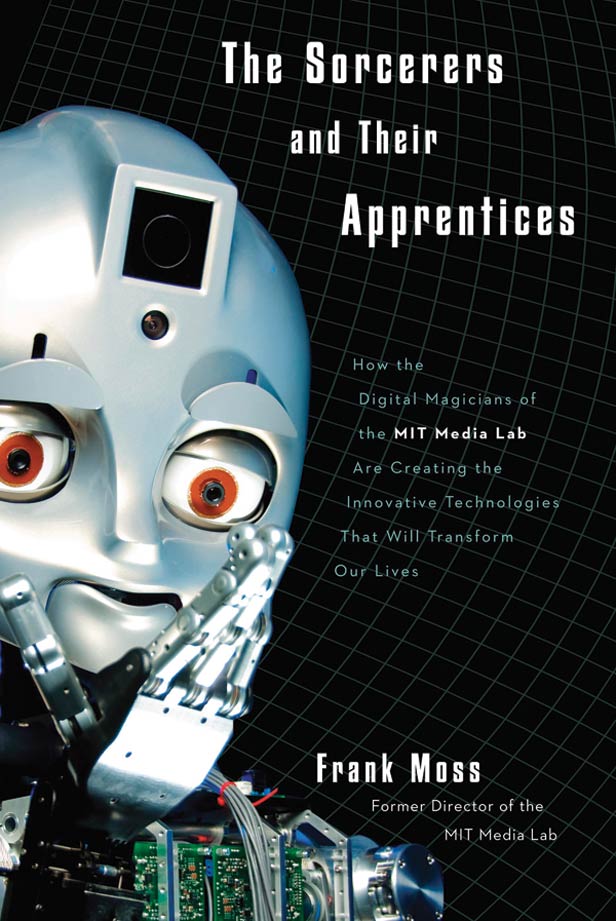
In its 25-year history, the MIT Media Lab has gotten publicity for unusual or playful inventions—a blender with a voice interface, for example, or wearable computing gear for pets. Frank Moss, SM ‘72, PhD ‘77, director of the lab from 2006 until earlier this year, wants to ensure that less media-friendly innovations developed there are recognized as well. His desire to highlight the lab’s contributions—and his belief that the creativity of the people who work there can inspire anyone—led him to write The Sorcerers and Their Apprentices: How the Digital Magicians of the MIT Media Lab Are Creating the Innovative Technologies That Will Transform Our Lives.
Moss, an entrepreneur who studied aeronautics and astronautics at MIT, has cofounded many companies and was CEO and chairman of Tivoli Systems, a provider of infrastructure management software, when it merged with IBM. When the opportunity to head the Media Lab came along, he couldn’t resist. “It’s so unique and so fascinating a place that as someone who has a lifelong interest in technology, innovation, and invention, I had to take that job,” he says. “It’s the sandbox of the entire world for that kind of thing.”
Moss was particularly interested in the potential for technology to address serious challenges, such as caring for the environment and improving human health. He was happy to find that the Media Lab “not only met my expectations, but exceeded them.” Inventions he mentions in the book include energy-generating robotic prosthetic feet, a foldable and stackable electric car, and technology that helps people with autism decipher facial expressions.
During his tenure as director, Moss took thousands of visitors through the lab, where the expected robots and monitors share space with sewing machines and soldering irons. He found that CEOs and elementary-school students alike had the same reaction: “Everybody goes away thinking, ‘How can I be more creative in my life?’” Today he is a professor of the practice at the lab as well as head of its New Media Medicine group, which uses technology to help patients take a more active role in managing their health. “The Media Lab is a source of inspiration to see what true creativity can really look like,” he says.
Moss says that any business can benefit from embracing the principle of creative freedom. “If you want to be innovative, to do something different, you have to create an environment where people are free to fail,” he says.
Unfettered creativity can lead to unexpected outcomes: Moss often found that projects yielded results the researchers hadn’t even considered when they began. “If you provide an environment where anything can happen, it will eventually,” he says. “In this country we’ve kind of eliminated the possibility of serendipity in the process of innovation. We want a specific outcome, and we lose track of the fact that some of the most meaningful innovations in the past didn’t start with the goal of addressing the problem they eventually solved.”
Recent Books
From the MIT community
Redesigning Leadership: Design,
Technology, Business, Life
By John Maeda ‘89, SM ‘89
MIT Press, 2011, $18.00
A High Price: The Triumphs and
Failures of Israeli Counterterrorism
By Daniel Byman, PhD ‘97
Oxford University Press, 2011, $34.95
Science for the Curious Photographer: An Introduction to the Science of Photography
By Charles S. Johnson Jr., PhD ‘61
A. K. Peters, 2010, $44.95
The Quest for a Fusion Energy
Reactor: An Insider’s Account
of the INTOR Workshop
By Weston M. Stacey ‘66
Oxford University Press, 2010, $24![]() .95
.95
Solar Module Packaging: Polymeric Requirements and Selection
By Michelle Poliskie, PhD ‘05
CRC Press, 2011, $149.95
Sudan at Peace
By William Jobin ‘59, SM ‘61
Boston Harbor Publishers, 2011, $19.00
A Muslim American Slave:
The Life of Omar Ibn Said
By Omar Ibn Said; translated from the Arabic, edited, and with an introduction by Ala Alryyes ‘85, SM ‘88
University of Wisconsin Press, 2011, $19.95
The Experience Economy,
updated edition
By B. Joseph Pine II, SM ‘91, and James H. Gilmore
Harvard Business Review Press, 2011, $24.95
Please submit titles of books and
papers published in 2010 and 2011
to be considered for this column.
Contact MIT News
E-mail mitnews@technologyreview.com
Write MIT News, One Main Street,
13th Floor, Cambridge, MA 02142
Fax 617-475-8043
Keep Reading
Most Popular
Large language models can do jaw-dropping things. But nobody knows exactly why.
And that's a problem. Figuring it out is one of the biggest scientific puzzles of our time and a crucial step towards controlling more powerful future models.
How scientists traced a mysterious covid case back to six toilets
When wastewater surveillance turns into a hunt for a single infected individual, the ethics get tricky.
The problem with plug-in hybrids? Their drivers.
Plug-in hybrids are often sold as a transition to EVs, but new data from Europe shows we’re still underestimating the emissions they produce.
Stay connected
Get the latest updates from
MIT Technology Review
Discover special offers, top stories, upcoming events, and more.